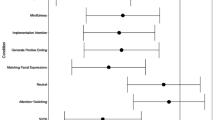Abstract
To evaluate a causal relationship between biased information processing and fear responding, as posited by many cognitive models of anxiety disorders, spider-relevant interpretations were trained to be non-threatening in an analog phobic sample. Participants high in spider fear (N = 61) were randomly assigned to a ‘Positive training’ condition, or to a ‘Neutral training’ or ‘No training’ control condition. ‘Positive training’ involved learning to ascribe non-threatening meanings to emotionally ambiguous scenarios. Results suggested this training was successful at inducing interpretation biases to be non-threatening, as indicated by faster responses to positive (versus negative) word fragments, as well as more positive and less negative interpretations of novel scenarios (relative to control conditions). Notwithstanding, the impact of training on subsequent avoidance and fear when presented with a live spider was minimal. No differences across training conditions were found; however, faster responding to positive word fragments predicted less avoidance and fear for participants receiving ‘Positive training’.


Similar content being viewed by others
Notes
There was a non-significant trend for higher baseline fear ratings in the Neutral training condition relative to the No training condition.
Note that the alternate analytic approach—conducting a three-way repeated measures MANOVA with training condition as the between-subjects factor, and valence (positive, negative) and spider-relevance (spider, non-spider) interpretation options as two separate within-subjects factors—was also significant (F(2, 58) = 34.63, p < 0.001, η2 = 0.54).
Thank you to an anonymous reviewer for this interesting suggestion.
References
Beard, C., Brady, R., & Amir, N. (2003). Malleability of interpretation bias in social anxiety. Poster presented at the annual meeting of the Association for the Advancement of Behavior Therapy, Boston, MA.
Beck, A. T., & Clark, D. A. (1997). An information processing model of anxiety: Automatic and strategic processes. Behaviour Research and Therapy, 35, 49–58.
Beck, A. T., Emery, G., & Greenberg, R. I. (1985). Anxiety disorders and phobias. New York: Basic Books.
Beck, A. T., Steer, R. A., & Brown, G. K. (1996). Beck depression inventory—II manual. San Antoino, TX: The Psychological Corporation.
Chambless, D. L., & Gillis, M. M. (1993). Cognitive therapy of anxiety disorders. Journal of Consulting and Clinical Psychology, 61, 248–260.
de Jong, P. J., Merckelbach, H., & Arntz, A. (1995). Covariation bias in phobic women: The relationship between a priori expectancy, on-line expectancy, autonomic responding, and a posteriori contingency judgment. Journal of Abnormal Psychology, 104, 55–62.
de Jong, P. J., & Muris, P. (2002). Spider phobia: Interaction of disgust and perceived likelihood of involuntary physical contact. Journal of Anxiety Disorders, 16, 51–65.
Foa, E. B., & Kozak, M. J. (1986). Emotional processing of fear: Exposure to corrective information. Psychological Bulletin, 99, 20–35.
Grey, S., & Mathews, A. (2000). Effects of training on interpretation of emotional ambiguity. Quarterly Journal of Experimental Psychology, 53, 1143–1162.
Harris, L. M., & Menzies, R. G. (1998). Changing attentional bias: Can it effect self-reported anxiety? Anxiety, Stress, and Coping, 11, 167–179.
Hertel, P. T., Mathews, A., Peterson, S., & Kintner, K. (2003). Transfer of training emotionally biased interpretations. Applied Cognitive Psychology, 17, 775–784.
Klorman, R., Weerts, T. C., Hastings, J. E., Melamed, B. G., & Lang, P. J. (1974). Psychometric description of some specific-fear questionnaires. Behavior Therapy, 5, 401–409.
MacLeod, C., Rutherford, E., Campbell, L., Ebsworthy, G., & Holker, L. (2002). Selective attention and emotional vulnerability: Assessing the causal basis of their association through the experimental manipulation of attentional bias. Journal of Abnormal Psychology, 111, 107–123.
Mathews, A., & Mackintosh, B. (2000). Induced emotional interpretation bias and anxiety. Journal of Abnormal Psychology, 109, 602–615.
Mathews, A., & MacLeod, C. (2002). Induced processing biases have causal effects on anxiety. Cognition and Emotion, 16, 331–354.
Realini, J. P., & Katerndahl, D. A. (1993). Factors affecting threshold for seeking care. Journal of American Board of Family Practice, 6, 215–223.
Szymanski, J., & O’Donohue, W. (1995). Fear of Spiders Questionnaire. Journal of Behavior Therapy and Experimental Psychiatry, 26, 31–34.
Teachman, B. A., Gregg, A., Woody, S. (2001). Implicit attitudes toward fear-relevant stimuli in individuals with snake and spider fears. Journal of Abnormal Psychology, 110, 226–235.
Teachman, B. A., & Woody, S. (2003). Automatic processing among individuals with spider phobia: Change in implicit fear associations following treatment. Journal of Abnormal Psychology, 112, 100–109.
Vasey, M. W., Hazen, R., & Schmidt, N. B. (2002). Attentional retraining for chronic worry and generalized anxiety disorder (GAD). Paper presented at the 36th annual meeting of the Association for the Advancement of Behavior Therapy, Reno, NV.
Watson, D., & Clark, L. A. (1994). Manual for the positive and negative affect schedule (expanded form). IA: University of Iowa.
Williams, J. M. G., Watts, F. N., MacLeod, C., & Mathews, A. (1997). Cognitive psychology and emotional disorders (2nd ed.). Chichester, England, UK: Wiley.
Wolpe, J., & Lang, P. J. (1964). A fear survey schedule for use in behaviour therapy. Behavior Research and Therapy, 2, 27–30.
Yiend, J., Mackintosh, B., & Mathews, A. (2005). Enduring consequences of experimentally induced biases in interpretation. Behaviour Research and Therapy, 43, 779–797.
Acknowledgments
The authors are thankful to Bundi Mackintosh for sharing study materials, and for the research assistance provided by members of the Teachman Program for Anxiety, Cognition, and Treatment (PACT) Lab.
Author information
Authors and Affiliations
Corresponding author
Rights and permissions
About this article
Cite this article
Teachman, B.A., Addison, L.M. Training Non-Threatening Interpretations in Spider Fear. Cogn Ther Res 32, 448–459 (2008). https://doi.org/10.1007/s10608-006-9084-z
Received:
Accepted:
Published:
Issue Date:
DOI: https://doi.org/10.1007/s10608-006-9084-z




